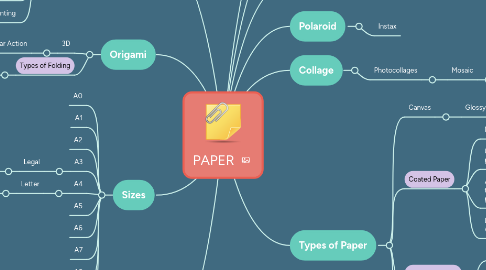
1. Mediums
1.1. Paint
1.1.1. Masonry Paint
1.1.1.1. Chalky
1.1.1.1.1. Matte
1.2. Ballpoint
1.2.1. Fountain
1.2.1.1. Roller Ball Pen
1.2.1.1.1. Marker
1.3. Print
1.3.1. Digital Print
1.3.2. Offset Print
1.3.3. Flexography
1.3.4. Letterpress Printing
1.3.5. Screen Printing
2. Origami
2.1. 3D
2.1.1. Modular Action
2.1.1.1. Kiragmi
2.1.1.1.1. Origami Paper
2.2. Types of Folding
2.2.1. Wetfolding
2.2.1.1. Fabric Folding
3. Sizes
3.1. A0
3.2. A1
3.3. A2
3.4. A3
3.4.1. Legal
3.4.1.1. 11"X14"
3.5. A4
3.5.1. Letter
3.5.1.1. 8.5"X11"
3.6. A5
3.7. A6
3.8. A7
3.9. A8
3.10. Tabloid
3.10.1. 11"X17"
4. Books
4.1. Book Sculpture
5. Density
6. Film
7. Card
7.1. Coloured Card
8. Polaroid
8.1. Instax
9. Collage
9.1. Photocollages
9.1.1. Mosaic
9.1.1.1. 3D Collage
9.1.1.1.1. Magazine Collage
10. Types of Paper
10.1. Canvas
10.1.1. Glossy
10.1.1.1. Bond Paper
10.2. Coated Paper
10.2.1. Matte Coated Paper
10.2.1.1. Silk Coated Paper
10.2.1.1.1. Watermarked Paper
10.2.2. Used for: magazines, books, photographs, professional publications
10.2.3. Advantage of Coated Paper: To ensure that the ink does not spread or diffuse into the paper
10.2.4. Disadvantage of Coated Paper: you can't write on it
10.3. Uncoated Paper
10.3.1. Forms
10.3.2. Letters
10.3.3. Newsprint
10.4. Finishing
10.4.1. Raw
10.4.2. Varnish
10.4.3. UV ( Ultra Violet )
10.4.4. Lamination

